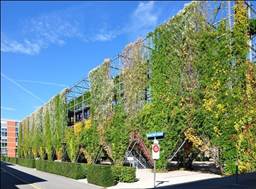

|
Green Screens |
||
| Applicability | ||
Green screen systems are extremely flexible. They can be applied to a variety of structures with potentially minimal impact to the structure itself, allowing for temporary or permanent and interior or exterior applications. The small footprint makes green screens especially great for utilizing and retrofitting large surface areas on buildings, but they have also been used as columns to define an open space, or as a freestanding structure such as a fence. The net impact of green screens has public benefits such as: reducing the urban heat island effect, improved exterior air quality, visual barrier and aesthetic improvement, biodiversity, and habitat. Private benefits may include: improved energy efficiency, building structure protection, improved indoor air quality (if used inside), noise reduction, privacy screening and shade, LEED credits, urban agriculture, and potential for self promotion/marketing. Jurisdictions have recognized the benefits of green screens as viable green infrastructure. For example, green screens can be applied towards LEED’s Sustainable Sites and Water Efficiency credits and all types of green walls meet requirements for vegetation cover in Seattle Green Factor program. |
||
